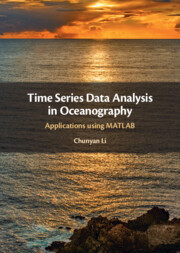Book contents
- Time Series Data Analysis in Oceanography
- Time Series Data Analysis in Oceanography
- Copyright page
- Contents
- Preface
- Acknowledgments
- 1 Introduction
- 2 Introduction to MATLAB
- 3 Time and MATLAB Functions for Time
- 4 Deterministic and Random Functions
- 5 Error and Variability Propagation
- 6 Taylor Series Expansion and Application in Error Estimate
- 7 Spherical Trigonometry and Distance Computation
- 8 A System of Linear Equations and Least Squares Method
- 9 Base Functions and Linear Independence
- 10 Generic Least Squares Method and Orthogonal Functions
- 11 Harmonic Analysis of Tide
- 12 Fourier Series
- 13 Fourier Transform
- 14 Discrete Fourier Transform and Fast Fourier Transform
- 15 Properties of Fourier Transform
- 16 More Discussion on the Harmonic Analysis and Fourier Analysis
- 17 Effect of Finite Sampling
- 18 Power Spectrum, Cospectrum, and Coherence
- 19 Window Functions for Reducing Side Lobes
- 20 Convolution, Filtering with the Window Method
- 21 Digital Filters
- 22 Rotary Spectrum Analysis
- 23 Short-Time Fourier Transform and Introduction to Wavelet Analysis
- 24 Empirical Orthogonal Function Analysis
- References
- Index
14 - Discrete Fourier Transform and Fast Fourier Transform
Published online by Cambridge University Press: 21 April 2022
- Time Series Data Analysis in Oceanography
- Time Series Data Analysis in Oceanography
- Copyright page
- Contents
- Preface
- Acknowledgments
- 1 Introduction
- 2 Introduction to MATLAB
- 3 Time and MATLAB Functions for Time
- 4 Deterministic and Random Functions
- 5 Error and Variability Propagation
- 6 Taylor Series Expansion and Application in Error Estimate
- 7 Spherical Trigonometry and Distance Computation
- 8 A System of Linear Equations and Least Squares Method
- 9 Base Functions and Linear Independence
- 10 Generic Least Squares Method and Orthogonal Functions
- 11 Harmonic Analysis of Tide
- 12 Fourier Series
- 13 Fourier Transform
- 14 Discrete Fourier Transform and Fast Fourier Transform
- 15 Properties of Fourier Transform
- 16 More Discussion on the Harmonic Analysis and Fourier Analysis
- 17 Effect of Finite Sampling
- 18 Power Spectrum, Cospectrum, and Coherence
- 19 Window Functions for Reducing Side Lobes
- 20 Convolution, Filtering with the Window Method
- 21 Digital Filters
- 22 Rotary Spectrum Analysis
- 23 Short-Time Fourier Transform and Introduction to Wavelet Analysis
- 24 Empirical Orthogonal Function Analysis
- References
- Index
Summary
This chapter introduces the fast Fourier Transform (FFT) for discrete Fourier Transform, beginning with the discretization of the Fourier Transform to its digital expression with constant time intervals. When the integral in Fourier Transform is replaced by a summation, the continuous Fourier Transform is changed to discrete. The discrete Fourier Transform and its inverse are exact relations. An example of the discrete Fourier Transform is discussed for a simple rectangular window function which results in the sinc function, useful for the interpretation of finite sampling effect. A technique of zero-padding is introduced with the discrete Fourier Transform for better visualization of the spectrum. But the computation of discrete Fourier Transform of a long time series can be quite “labor intensive” or costly in computer time with a direct computation. However, since the base functions are periodic, a direct computation can have many duplications in multiplications of terms. Algorithms can be designed to reduce the duplications so that the speed of computation is increased. The reduction of duplicated computations can be repeatedly done through an FFT algorithm. In MATLAB, this is done by a simple command fft. The efficiency of FFT is discussed.
Keywords
Information
- Type
- Chapter
- Information
- Time Series Data Analysis in OceanographyApplications using MATLAB, pp. 242 - 266Publisher: Cambridge University PressPrint publication year: 2022
Accessibility standard: Unknown
Why this information is here
This section outlines the accessibility features of this content - including support for screen readers, full keyboard navigation and high-contrast display options. This may not be relevant for you.Accessibility Information
- 1
- Cited by
